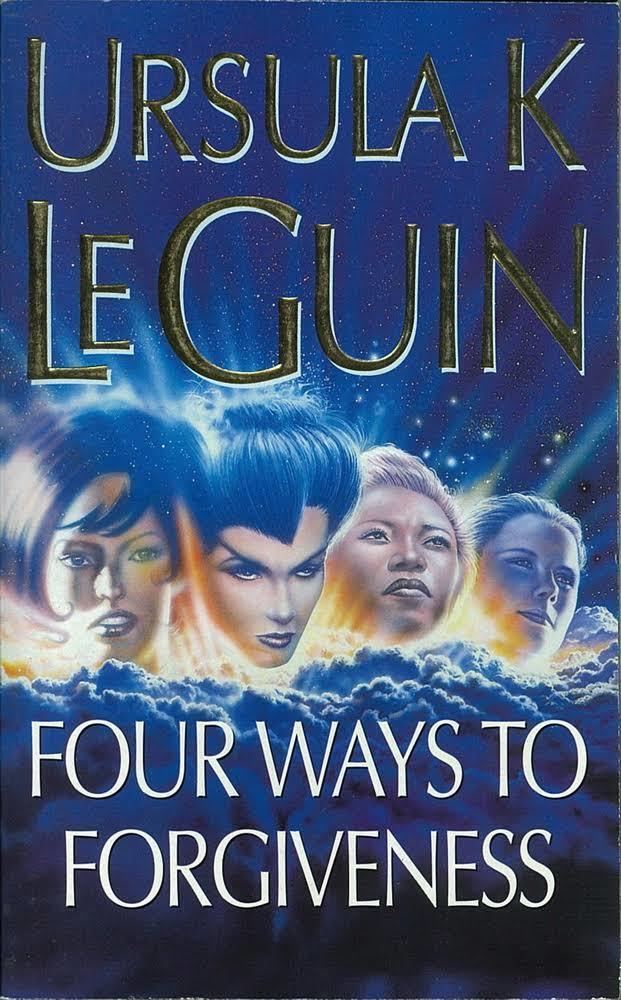8.2 /10 1 Votes8.2
Country United States Pages 228 | 4.1/5 Goodreads Language English Publication date 1995 Originally published 1995 Page count 228 | |||||||||||||||||||||||||||||||||
 | ||||||||||||||||||||||||||||||||||
Media type Print (hardback & paperback) Preceded by The Word for World Is Forest Genres Fantasy, Short story, Science Fiction, Speculative fiction Similar Ursula K Le Guin books, Hainish Cycle books, Science Fiction books | ||||||||||||||||||||||||||||||||||
Four Ways to Forgiveness is a collection of four short stories or novellas by Ursula K. Le Guin. All four stories are set in the future and deal with the planets Yeowe and Werel, both members of the Ekumen, a collective of planets used by Le Guin as part of the background for many novels and short stories in her Hainish Cycle.
Contents
Setting
The stories in the book are set on two planets in a distant solar system, Werel and Yeowe, inhabited by humans placed there by the ancient Hainish. (This 'Werel' is not the same as the world called Werel in Le Guin's Planet of Exile and City of Illusions.) Werel has a long history of institutional enslavement of its lighter-skinned ethnic groups by its darkner-skinned ethnic groups (the latter's derogatory term for the former is "dusties"). When the Ekumen recontacted the Werelians, the shock spurred one of the Werelian nations, Voe Deo, to develop a space program and settle the other inhabitable planet in the system, Yeowe, transporting a primarily slave population to do so. Eventually the slaves on Yeowe conducted a successful revolt and gained their independence, an event that occurred in the fairly recent past of the four stories. The nations of Werel are nervous that the "assets" on that planet might attempt the same thing for themselves.
Contents
The second, third and fourth stories have some characters in common. Havzhiva from story three works for Solly from Story Two. He is also the lover of Rakam in Story Four, mentioned but not named in Story Three. Both of them know Dr Yeron, and also Esdardon Aya, 'Old Music'. 'Old Music' is a minor character in Story Two, and the protagonist in the separate short story Old Music and the Slave Women in the collection The Birthday of the World.
The book ends with Notes on Werel and Yeowe, giving details of the two planets and their solar system.
Themes
The common themes of the stories revolve around the concepts of freedom and slavery. For thousands of years, the dark-skinned owners of Werel held the light-skinned assets in slavery. However, in recent years, following the colonization of the second planet, Yeowe, things have begun to change on Werel. The Yeowans have gained freedom and are struggling to establish their own government and identity, and gain admittance into the Ekumen of worlds.
Gender relations are another area examined by the stories. In its initial years of settlement, only male slaves were transported to Yeowe, leading to a hypermasculine culture and formalized homosexual relationships among them, both of which had a strong impact on later gender relations on Yeowe. In the second story of the book, Sully associates with a Werelian member of a class of traditional transvestite entertainers, and the fourth story features Rakam reflecting on how her new experience of freedom from formal slavery is conditioned by her position as a woman in a still-sexist society.
Publication history
The collection was first published by Harper Paperbacks (a division of HarperCollins Publishers) in 1995. Betrayals first appeared in 1994 in Blue Motel. The others appeared in the science fiction magazine Asimov's in 1994 and 1995.
Four Ways to Forgiveness was published in 1995 in a leather-bound, signed edition by Easton Press, who describe themselves as releasing 'works of lasting meaning, beauty and importance.'
Reception and critical analysis
Four Ways to Forgiveness has been referred to as a story-suite by critics, based on Le Guin's own use of the term to describe her deliberate inclusion of linked short stories in book form. Le Guin has remarked that the collections of stories could have been a novel had she focused on a few characters; instead she decided to focus on a work with many voices.
